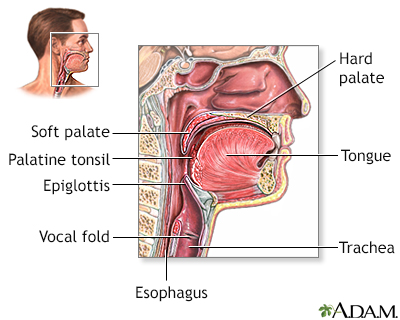Painful swallowing
Swallowing - pain or burning; Odynophagia; Burning feeling when swallowing, dysphagia
Painful swallowing is any pain or discomfort while swallowing. You may feel it high in the neck or lower down behind the breastbone. Most often, the pain feels like a strong sensation of squeezing or burning. Painful swallowing may be a symptom of a serious disorder.
Images

Animation

I Would Like to Learn About:
Considerations
Swallowing involves many nerves and muscles in the mouth, throat area, and food pipe (esophagus). Part of swallowing is voluntary. This means you are aware of controlling the action. However, much of swallowing is involuntary once it starts.
Problems at any point in the swallowing process (including chewing, moving food to the back of the mouth, or moving it to the stomach) can result in painful swallowing.
Swallowing problems can cause symptoms such as:
- Chest pain
- Feeling of food stuck in the throat
- Heaviness or pressure in the neck or upper chest while eating
Causes
Swallowing problems may be due to infections, such as:
- Cytomegalovirus
- Gum disease (gingivitis)
- Herpes simplex virus
- Human immunodeficiency virus (HIV)
- Pharyngitis (sore throat)
- Thrush (yeast infection of the mouth)
- Yeast infection of the esophagus
Swallowing problems may be due to a problem with the esophagus, such as:
- Achalasia
- Esophageal spasms
- Gastroesophageal reflux disease (GERD)
- Inflammation of the esophagus
- Nutcracker esophagus
- Ulcer in the esophagus, especially due to tetracyclines (antibiotic), aspirin, and nonsteroidal anti-inflammatory drugs (NSAIDs) such as ibuprofen or naproxen
- Eosinophilic esophagitis
Other causes of swallowing problems include:
- Mouth or throat ulcers
- Something stuck in the throat (for example, fish or chicken bones)
- Tooth infection or abscess
Home Care
Some tips that may help you to ease swallowing pain at home include:
- Eat slowly and chew your food well.
- Eat pureed foods or liquids if solid foods are hard to swallow.
- Avoid very cold or very hot foods if they make your symptoms worse.
If someone is choking, immediately perform the Heimlich maneuver.
When to Contact a Medical Professional
Contact your health care provider if you have painful swallowing and:
- Blood in your stools or your stools appear black or tarry
- Shortness of breath or lightheadedness
- Weight loss
Tell your provider about any other symptoms that occur with the painful swallowing, including:
- Abdominal pain
- Chills
- Cough
- Fever
- Heartburn
- Nausea or vomiting
- Sour taste in the mouth
- Wheezing
What to Expect at Your Office Visit
Your provider will examine you and ask about your medical history and symptoms, including:
- Do you have pain when swallowing solids, liquids, or both?
- Is the pain constant or does it come and go?
- Is the pain getting worse?
- Do you have difficulty swallowing?
- Do you have a sore throat?
- Does it feel like there is a lump in your throat?
- Have you inhaled or swallowed any irritating substances?
- What other symptoms do you have?
- What other health problems do you have?
- What medicines do you take?
The following tests may be done:
- Endoscopy with biopsy
- Barium swallow and upper GI series
- Chest x-ray
- Esophageal pH monitoring (measures acid in the esophagus)
- Esophageal manometry (measures pressure in the esophagus)
- Esophagogastroduodenoscopy (EGD)
- HIV testing
- Neck x-ray
- Throat culture
References
Allen CT, Nussenbaum B, Merati AL. Acute and chronic laryngopharyngitis. In: Flint PW, Francis HW, Haughey BH, et al, eds. Cummings Otolaryngology: Head and Neck Surgery. 7th ed. Philadelphia, PA: Elsevier; 2021:chap 61.
DeVault KR. Symptoms of esophageal disease. In: Feldman M, Friedman LS, Brandt LJ, eds. Sleisenger and Fordtran's Gastrointestinal and Liver Disease: Pathophysiology/Diagnosis/Management. 11th ed. Philadelphia, PA: Elsevier; 2021:chap 13.
Pandolfino JE, Kahrilas PJ. Esophageal neuromuscular function and motility disorders. In: Feldman M, Friedman LS, Brandt LJ, eds. Sleisenger and Fordtran's Gastrointestinal and Liver Disease: Pathophysiology/Diagnosis/Management. 11th ed. Philadelphia, PA: Elsevier; 2021:chap 44.
Wilcox CM. Gastrointestinal consequences of infection with human immunodeficiency virus. In: Feldman M, Friedman LS, Brandt LJ, eds. Sleisenger and Fordtran's Gastrointestinal and Liver Disease: Pathophysiology/Diagnosis/Management. 11th ed. Philadelphia, PA: Elsevier; 2021:chap 35.
BACK TO TOPReview Date: 8/7/2023
Reviewed By: Michael M. Phillips, MD, Emeritus Professor of Medicine, The George Washington University School of Medicine, Washington, DC. Also reviewed by David C. Dugdale, MD, Medical Director, Brenda Conaway, Editorial Director, and the A.D.A.M. Editorial team.

Health Content Provider
06/01/2025
|
A.D.A.M., Inc. is accredited by URAC, for Health Content Provider (www.urac.org). URAC's accreditation program is an independent audit to verify that A.D.A.M. follows rigorous standards of quality and accountability. A.D.A.M. is among the first to achieve this important distinction for online health information and services. Learn more about A.D.A.M.'s editorial policy, editorial process and privacy policy. A.D.A.M. is also a founding member of Hi-Ethics. This site complied with the HONcode standard for trustworthy health information from 1995 to 2022, after which HON (Health On the Net, a not-for-profit organization that promoted transparent and reliable health information online) was discontinued. |
The information provided herein should not be used during any medical emergency or for the diagnosis or treatment of any medical condition. A licensed medical professional should be consulted for diagnosis and treatment of any and all medical conditions. Links to other sites are provided for information only -- they do not constitute endorsements of those other sites. © 1997- 2025 A.D.A.M., a business unit of Ebix, Inc. Any duplication or distribution of the information contained herein is strictly prohibited.
